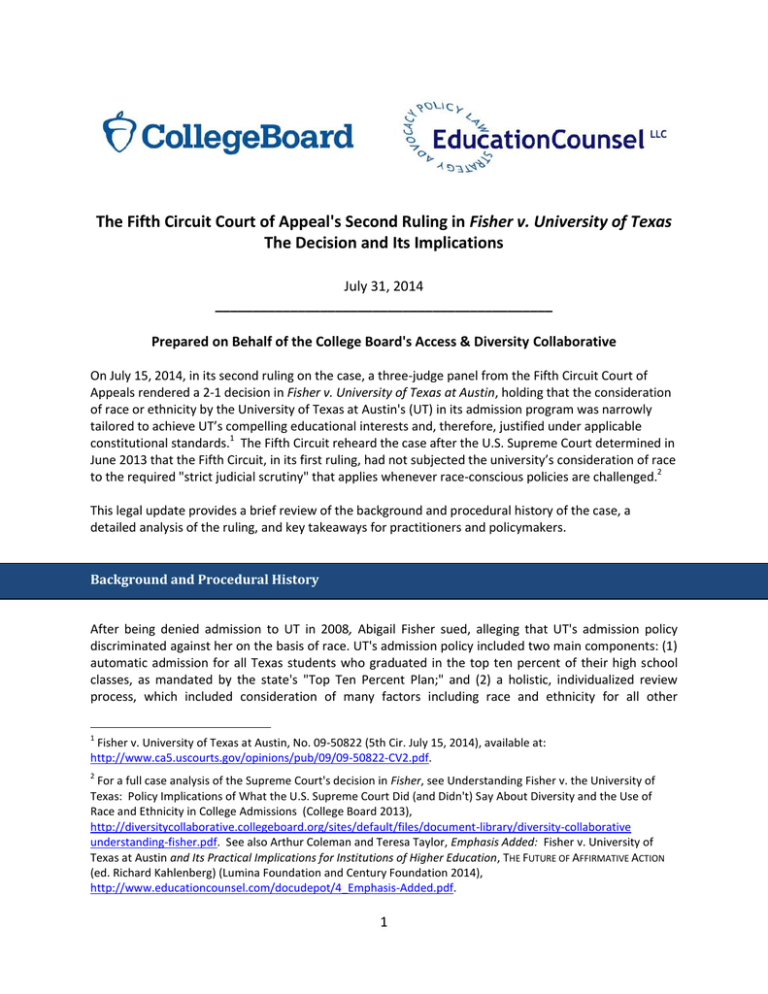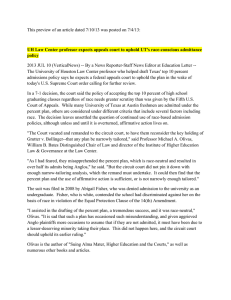
The Fifth Circuit Court of Appeal's Second Ruling in Fisher v. University of Texas
The Decision and Its Implications
July 31, 2014
_____________________________________________
Prepared on Behalf of the College Board's Access & Diversity Collaborative
On July 15, 2014, in its second ruling on the case, a three-judge panel from the Fifth Circuit Court of
Appeals rendered a 2-1 decision in Fisher v. University of Texas at Austin, holding that the consideration
of race or ethnicity by the University of Texas at Austin's (UT) in its admission program was narrowly
tailored to achieve UT’s compelling educational interests and, therefore, justified under applicable
constitutional standards.1 The Fifth Circuit reheard the case after the U.S. Supreme Court determined in
June 2013 that the Fifth Circuit, in its first ruling, had not subjected the university’s consideration of race
to the required "strict judicial scrutiny" that applies whenever race-conscious policies are challenged.2
This legal update provides a brief review of the background and procedural history of the case, a
detailed analysis of the ruling, and key takeaways for practitioners and policymakers.
Background and Procedural History
After being denied admission to UT in 2008, Abigail Fisher sued, alleging that UT's admission policy
discriminated against her on the basis of race. UT's admission policy included two main components: (1)
automatic admission for all Texas students who graduated in the top ten percent of their high school
classes, as mandated by the state's "Top Ten Percent Plan;" and (2) a holistic, individualized review
process, which included consideration of many factors including race and ethnicity for all other
1
Fisher v. University of Texas at Austin, No. 09-50822 (5th Cir. July 15, 2014), available at:
http://www.ca5.uscourts.gov/opinions/pub/09/09-50822-CV2.pdf.
2
For a full case analysis of the Supreme Court's decision in Fisher, see Understanding Fisher v. the University of
Texas: Policy Implications of What the U.S. Supreme Court Did (and Didn't) Say About Diversity and the Use of
Race and Ethnicity in College Admissions (College Board 2013),
http://diversitycollaborative.collegeboard.org/sites/default/files/document-library/diversity-collaborative
understanding-fisher.pdf. See also Arthur Coleman and Teresa Taylor, Emphasis Added: Fisher v. University of
Texas at Austin and Its Practical Implications for Institutions of Higher Education, THE FUTURE OF AFFIRMATIVE ACTION
(ed. Richard Kahlenberg) (Lumina Foundation and Century Foundation 2014),
http://www.educationcounsel.com/docudepot/4_Emphasis-Added.pdf.
1
applicants.3 In the 2008 UT admission cycle, approximately 80 percent of students were admitted
through the Top Ten Percent Plan and approximately 20 percent were admitted through the holistic
review process.
The federal district court that first heard Fisher's case upheld UT's admission policy under principles for
the strict scrutiny analysis established in the U.S. Supreme Court's decision in Grutter v. Bollinger (2003),
which built on Justice Powell's opinion in Regents of the University of California v. Bakke (1978).4 The
district court was affirmed by a unanimous three judge panel from the Fifth Circuit. Though he joined
the majority based on existing precedent, Fifth Circuit Judge Emilio Garza wrote a special concurrence to
the decision inviting Supreme Court review, questioning the Grutter holding and contending that
Grutter's identification of educational benefits of diversity as a compelling interest rested on hypothesis,
speculation, and intuition. He concluded that the Supreme Court's "failing" was that "it approved the
use of race in university admissions as a compelling state interest at all." He also found that Grutter's
narrow tailoring analysis set "a peculiarly low bar" for institutions.
The U.S. Supreme Court accepted Fisher's appeal and, in a 7-1 ruling,5 reaffirmed that the educational
benefits of diversity are a compelling interest, but concluded that the Fifth Circuit had afforded
unwarranted deference to UT in its evaluation of the means by which UT sought to attain its diversity
goals. It did not rule on the merits of UT's admission policy and remanded the case back to the Fifth
Circuit for resolution under the strict judicial scrutiny standard clarified by its Fisher decision.
The Ruling
Following a new round of briefing from the parties and additional oral arguments, the Fifth Circuit
rendered a 2-1 decision, once again upholding UT's admission policy.
The court concluded that UT's limited race-conscious holistic review process reflected a necessary step
in achieving its particular diversity goals. This was particularly so given the substantial impact of the
"mechanical," "single dimension" Top Ten Percent Plan that "standing alone . . . was not a workable
means of achieving" the robust, multifaceted diversity sought by UT. Because the holistic review
process provided an avenue for admitting highly competitive students "of unique talents and
backgrounds who [could] enrich the diversity of the student body in distinct ways," the court deemed it
3
For a complete review of the facts in Fisher (including a detailed look at UT's admission process) and the Fifth
Circuit's first decision, see Legal Update: Fisher v. University of Texas Case Summary (College Board 2011),
http://diversitycollaborative.collegeboard.org/sites/default/files/document-library/fisher_v_univ_texas_final.pdf.
4
Under federal law, race- or ethnicity-based classifications are inherently suspect, disfavored by courts, and
subject to "strict scrutiny," the most rigorous standard of judicial review. Strict scrutiny requires all public
institutions and all private institutions that receive federal funding only to use race or ethnicity as a factor in
conferring benefits or opportunities to students if they can establish that such race- and ethnicity-conscious
policies or practices serve a "compelling state interest" and are "narrowly tailored" to serve that interest. Strict
scrutiny should not apply to policies and practices that are inclusive and do not result in excluding individuals
based on their race or ethnicity. U.S. Const. amend XIV; § 1; 42 U.S.C. § 2000d; Grutter v. Bollinger, 539 U.S. 306
(2003); see also Understanding Fisher, note 2 above.
5
Justice Kagan was recused from the case, resulting in only eight of nine Justices participating in Fisher.
2
"a necessary and enabling component of the Top Ten Percent Plan" that "complements [Top Ten
admittees'] contributions to diversity – mitigating in an important way the effects of a single dimension
process." The court observed that including race and ethnicity as "a factor of a factor" in this highly
competitive process was important because lingering gaps in standardized test scores among racial and
ethnic student groups may have caused holistic review to otherwise "approach an all-white enterprise."
In response to the U.S. Supreme Court's critique of its previous examination of UT's consideration of
race-neutral alternatives, the Fifth Circuit documented a variety of race-neutral policies pursued by UT
(including the Top Ten Percent Plan) that, alone, had not yielded UT's desired diversity.
Notably, the Fisher decision is rooted in the highly fact- and context-specific nature of the case, with the
court referring to UT's admissions policy as a "unique creature" that offers "no template for others."
In his dissent, Judge Garza focused his critique of the majority ruling on UT's failure to "define with
clarity" its goals and objectives as a foundation for evaluating its race-conscious holistic review policy.
More specifically, he argued that the majority failed to "make a meaningful inquiry" into the "critical
mass" that UT asserted as its diversity objective – finding UT's articulation of its interests to be
"unknown, unmeasurable, or unclear." At the same time, though he found that UT had failed to justify
its race-conscious policy, he acknowledged the possibility that "a public university [could] define its
diversity ends adequately for a court to verify narrow tailoring with the requisite exacting scrutiny" –
reflecting a shift from his concurrence in the Fifth Circuit's first hearing of the case.
The Fifth Circuit's decision is binding only within its jurisdiction (Louisiana, Mississippi, and Texas), but
may be persuasive in the other jurisdictions. And the decision may not be final. On July 30, 2014,
Fisher's attorneys filed an appeal to the full Fifth Circuit for "en banc" review.6 Eventually, the decision
could even return to the U.S. Supreme Court, if the Court decides to hear the case again.
Key elements of the Fifth Circuit's 2014 Fisher ruling include:
1. Affirmation of the compelling interest reflected in UT's diversity goals, which are "defined by
reference to the educational benefits that diversity is designed to produce." The court reaffirmed
the diversity-related educational benefits of: (a) improved educational quality; (b) preparation for
students as professionals in a global marketplace; and (c) enhancement of civic readiness.
2. Rejection of a numbers-exclusive focus as a condition of sanctioning UT’s critical mass objectives.
While recognizing the relevance of numbers to a judgment regarding critical mass, the court
affirmed UT's critical mass focus – defined "by reference to a broader view of diversity" reflected in
the holistic review of its individual applicants. In the court's view (and consistent with UT's
argument), critical mass could not reflect "achievement of a certain quota of minority students." 7
6
In the last round of litigation, the full Fifth Circuit declined to hear Fisher's appeal. She then appealed directly to
the Supreme Court.
7
The court's conclusions were almost certainly guided by UT's briefs, which described UT's annual review of
progress toward its critical mass objectives on "various data points including but not limited to enrollment figures;
evidence of racial isolation and the racial climate on campus (which includes reports of racially hostile or
insensitive conduct), including feedback from faculty and students; and other data including the educational
benefits of diversity experienced in the classroom." Supplemental Brief for Appellees, Fisher v. Univ. of Texas at
Austin (No. 09-50822), at 48, available at: http://www.utexas.edu/vp/irla/Documents/2013-10-25-UT-
3
3. Affirmation that UT’s holistic review process was lawful, because it:
Admitted students of all races and ethnicities, as well as those with unique talents, backgrounds,
and life experiences, thereby mitigating the effects of the "single dimension" Top Ten Percent
Plan that was based only on high school class rank
Supplemented the Top Ten Percent Plan "allow[ing] selection of an overwhelming number of
students by facially neutral measures, and for the remainder race [was] only a factor of factors"
Was "nearly indistinguishable" from the University of Michigan Law School’s program, upheld in
Grutter, with its focus on individualized review of each applicant based on a wide array of
factors designed to achieve "multi-dimensional" diversity
Admitted only "highly qualified" and "competitive" students
4.
Affirmation that UT’s consideration of race in its holistic review process was necessary. The court
concluded that the holistic review process made "the Top Ten Percent Plan workable by patching
the holes that a mechanical admissions program leaves in its ability to achieve the rich diversity that
contributes to its academic mission." The court also observed that the "low numbers" of
underrepresented minority students yielded by the holistic review was the process's "strength, not
its weakness."8
5. Recognition that UT satisfied its burden with respect to the consideration and pursuit of raceneutral strategies, including:
The Top Ten Percent Plan, a facially-neutral process through which the vast majority of students
were admitted
Outreach "targeting under-represented demographics, including the over half of Texas high
school graduates that are African-American or Hispanic"
Scholarships awarded based on socio-economic and/or first generation status
Expansion of UT's recruitment and outreach efforts "by increasing its recruitment budget by
$500,000, by adding three regional admissions centers in Dallas, San Antonio, and Harlingen [a
"significant investment" with 13 new staff members], by engaging in outreach programs that
brought prospective students to UT Austin for daylong or overnight visits, and by hosting multiday campus conferences for high school counselors"
Fisher.Supp.Br.pdf. On the issue of examining critical mass within individual classrooms, citing a UT classroom
diversity study that showed that "African-American and Hispanic students were nearly non-existent in thousands
of classes," UT explained that, though it "never pursued classroom diversity as a discrete interest or endpoint . . .
this palpable lack of diversity in the classrooms – one of many factors UT considered – underscored that UT had not
yet fully realized the educational benefits of diversity." Id. at 46.
In dissent, while Judge Garza agreed that critical mass "does not require a precise numerical definition," he
asserted that "clarity" regarding institutional goals was essential, and that meaningful strict scrutiny review
required "concrete targets" and knowable ends upon which to gauge the sufficiency of race-conscious means. He
concluded that UT's "nebulous amalgam of factors – enrollment data, racial isolation, racial climate, and 'the
educational benefits of diversity'" was a "bare submission" that "beg[ged] for the deference that is irreconcilable
with 'meaningful' judicial review."
8
In dissent, Judge Garza challenged the necessity of using race and ethnicity in a holistic review program that only
admitted 216 African-American and Latino students in an entering class of 6,322, objecting that UT "failed to
explain how this small group contributes to its 'critical mass' objective."
4
Creation of the Financial Aid Outreach Group "to visit high schools to help prospective students
'understand the financial support offered' . . . and 'to convince low income students that money
should not be a barrier to attending college'"
Notably, in line with the Supreme Court's instruction that an institution is not bound to exhaust
"every conceivable race-neutral alternative," the court concluded that – contrary to Fisher's
argument – UT was not bound to replace consideration of race and ethnicity entirely with
consideration of socio-economic status. (The court briefly reviewed evidence that socio-economic
status is not a proxy for race and ethnicity and observed, "Bakke accepts that skin color matters – it
disadvantages and ought not be relevant but it is.")
Key Takeaways
The Fifth Circuit's new decision may itself be a "unique creature," with its conclusions inextricable from
the details of UT's admission policy. Nevertheless, the decision is worth examining for those lessons and
questions that have relevance for other institutions and the broader field. These include:
1. The educational benefits of diversity remain a compelling interest that may justify race- and
ethnicity-conscious policies and practices in appropriate circumstances.
Consistent with principles emanating from the U.S. Supreme Court's decisions in Bakke, Grutter, Gratz,
and Fisher, the Fifth Circuit's decision illustrates that institutions may pursue appropriately designed
race- and ethnicity-conscious policies to achieve the educational benefits of diversity. Indeed, the
decision illustrates (in the Supreme Court's parlance) that while strict scrutiny may be "strict in theory" it
is neither "feeble" nor "fatal in fact."
In framing the educational benefits of diversity as a matter of institutional policy, institutions of higher
education should reflect upon the very similar benefits affirmed by the Supreme Court in Grutter and reaffirmed by the Fifth Circuit in Fisher: improved teaching and learning; preparation for the workforce in
a global economy; and civic readiness. Where appropriate, institutions should connect these broad
benefits to their specific missions and accompanying educational goals. Medical schools, for example,
have connected their diversity goals with the need to provide medical care to diverse populations,
particularly underserved populations.9
9
See, e.g., Roadmap to Diversity: Key Legal and Educational Policy Foundations for Medical Schools (1st ed., AAMC
2008), https://members.aamc.org/eweb/upload/Roadmap%20to%20Diversity%20Key%20Lergal.pdf.
5
2. Critical mass, a contextual benchmark for success on achievement of diversity-related goals, may
be assessed and informed by objective and subjective evidence. The issue, however, remains one
of significant debate.
When determining whether to re-institute a race-conscious holistic review process after the Supreme
Court's 2003 Grutter decision,10 UT "based its critical mass determination on several data points,
including hard data on minority admissions, enrollment, and racial isolation at UT, as well as discussion
with students about their own experiences at UT and faculty observations." 11 Elaborating, UT called
attention to the "jarring evidence of racial isolation," including evidence that "African American and
Hispanic students were nearly non-existent in thousands of classes." This body of evidence led UT to
determine that its critical mass objectives were not being met by neutral strategies alone and that a
modest inclusion of race and ethnicity as "a factor of factors" was a necessary part of the holistic review
process. UT continues to assess annually its critical mass objectives using multiple sources of evidence
related to enrollment and campus climate, thus connecting the action of the admissions office with the
educational work of the institution at large.
The absence in UT's critical mass formulation of a "clear and definite articulation of its goal" resulting in
"undefined ends" led, at least in part, dissenting Judge Garza to reject its policy on the grounds that a
reviewing court could not fulfill its duty in fully applying strict scrutiny standards. The majority did not
directly address this critique. With the Fisher majority and dissenting opinions echoing the majority and
dissenting opinions in Grutter, this debate is likely to continue for some time.
There are some key guideposts for institutions on critical mass. For an institution pursuing raceconscious policies, it is not enough to identify the attainment of the educational benefits of diversity as
part of the institutional mission without also determining accompanying objectives (i.e., how success
against that goal should be assessed). Institutions should ensure that their desired outcomes are clearly
framed with sufficient precision so that they have adequate baselines upon which to gauge the success
of their policies over time – and that the evidence they amass can justify the continuing consideration of
race as part of a holistic review process. The decision in Fisher indicates that institutions may use
different data and information sources and then assess goals and objectives accordingly.
3. Consideration and pursuit of neutral strategies are essential. Institutions should establish a
comprehensive inventory of race-conscious and -neutral strategies (and the relevant evaluation of
each with respect to diversity goals) to establish the necessity of pursuing race-conscious
strategies because "available, workable race-neutral alternatives [alone] do not suffice."
As described above, the court specifically examined UT's array of neutral strategies beyond the Top Ten
Percent Plan, including outreach, recruitment, and scholarship efforts, many of which were targeted
specifically at low income and underserved students (in the Texas context, these students also tend to
be racial and ethnic minorities).
10
From 1997 to 2003, UT was governed by the Fifth Circuit's Hopwood decision, which forbid the consideration or
race and ethnicity in admission but was eventually overruled by Grutter. Hopwood only applied in the Fifth
Circuit's jurisdiction (Louisiana, Mississippi, and Texas).
11
Supplemental Brief for Appellees, note 7 above, at 33-34.
6
The task of cataloguing race-conscious and race-neutral strategies to demonstrative a cohesive,
comprehensive diversity policy should be broadly instructive to institutions. All policies and practices
that contribute to the achievement of an institution's diversity goals should be examined individually
and collectively for their effectiveness and impact. But it is unlikely that UT's race-neutral approach can
(or should) serve as a blueprint for the vast majority of race-conscious institutions because of the
significant, state-mandated role that the Top Ten Percent Plan played in UT's admission policy.
Moreover, UT's case was enhanced by a history in which it was required to use an entirely race-neutral
admission program for six years12 – meaning that it could more easily "demonstrate, before turning to
racial classifications, that available, workable neutral alternatives do not suffice" (emphasis added).
Institutions should consider UT as a reference point, rather than a model, and undertake their own raceneutral analyses with their own contexts and histories front and center. 13
4. A race-conscious holistic review process should result in the admission of students who are
individually deemed qualified and likely to succeed, with qualities and backgrounds that can
contribute to student diversity.
One of the strengths of UT's position, as reflected in the majority opinion, was the fact that the students
admitted through UT's holistic review process all met "the competitive academic bar of admissions" and
had "unique qualities that complement[ed] the contributions of the Top Ten Percent Plan admittees." In
other words, all admitted students – whether admitted through the Top Ten Percent Plan or the holistic
review process – were academically qualified to attend UT. After determining basic academic eligibility,
UT's holistic review process involved individualized review of each applicant's file, with its focus on
admitting students "with demonstrated qualities of leadership and sense of self" and with "unique
talents and backgrounds" – qualities that the rigid Top Ten Percent Plan was incapable of assessing.
Institutions of higher education pursuing race-conscious holistic reviews should ensure that their file
reviews focus on the full array of backgrounds and characteristics important to the fulfillment of
institutional diversity goals. They should also establish basic academic eligibility for all students before
assessing other experiences and attributes such as race and ethnicity.
12
These six years refer to the time period (1997-2003) when UT was governed by the Hopwood decision. See note
10 above.
13
A September 2013 resolution agreement between the U.S. Department of Education's Office for Civil Rights and
Rice University that approved Rice's limited use of race and ethnicity in its holistic admissions program may be
instructive on this point. In reaching its conclusion, OCR examined a wide array of neutral strategies employed by
Rice (e.g., enhancing recruitment efforts for underrepresented students, participation in more than 70 outreach
programs, revising admissions metrics, expanding socioeconomic diversity, and offering scholarships specifically
for students who can help bridge racial and cultural differences). Rice concluded that this wide array of strategies
was not sufficient to meet its diversity goals – described specifically in the context of having "a critical mass of
underrepresented students as would be necessary to develop a meaningful level of participation by those students
in each of its nine residential colleges." (Like UT, Rice also was governed by Hopwood 1997-2003). Office for Civil
Rights, U.S. Dep't of Education, Complaint Resolution for OCR Complaint #06052020 (Rice University) (Sept. 10,
2013). http://www2.ed.gov/about/offices/list/ocr/docs/investigations/06052020-a.html.
7
5. Facts matter. The establishment of educationally sound, legally sustainable diversity policies is
ultimately dependent on institution-specific evidence aligned with institutional mission.
The conceptualization and implementation of diversity programs are highly dependent on an
institution's unique mission, context, and setting. (In fact, the U.S. Supreme Court in Fisher specifically
acknowledged that even within a strict scrutiny analysis, courts should "take account of a university's
experience and expertise in adopting or rejecting certain admissions processes.") As UT's efforts
demonstrate, though an institution may be informed by other models and broad-based research may
inform institutional judgments, it must base its decisions regarding its race-conscious practices on its
own theory of action, logic, and supporting evidence.
There is no doubt that UT's holistic review process's similarity to that established by the University of
Michigan Law School (approved by the U.S. Supreme Court in Grutter) contributed to the Fifth Circuit's
decision. At the same time, however, the court observed that UT's policy is "a unique creature." Noting
Justice O'Connor's observation in Grutter that "context matters," the court concludes that the
combination of UT's percent plan, UT's limited holistic review process for those students not admitted
through the percent plan, and the Texas context "offers no template for others."
Though a new chapter to the diversity legal canon has been added, the issues addressed in Fisher are far
from over. Though UT has won the day for now, questions raised by Judge Garza's dissent echo those
raised by Justice Kennedy's dissent in Grutter. Institutions should take heart that race-conscious
programs may continue to be legally permissible when appropriately justified – including in a post-Fisher
world. But institutions should not assume that the challenge of designing and implementing effective
and legally permissible diversity strategies has subsided. Using the gift of time granted by the Supreme
Court and now the Fifth Circuit in their Fisher decisions, institutions should work to ensure that their
race-conscious diversity goals and accompanying strategies have appropriate support and justification –
including a serious consideration and appropriate use of workable race-neutral strategies.
8
This guidance was prepared by EducationCounsel LLC on behalf of the College Board's Access &
Diversity Collaborative. The Collaborative provides general policy, practice, legal and strategic
guidance to colleges, universities, and state systems of higher education to support their
independent development and implementation of access- and diversity-related enrollment
policies. For more information regarding the Collaborative, please visit
http://diversitycollaborative.collegeboard.org/
The Collaborative is grateful to the members of its "Rapid Response Team" for their assistance
in the preparation of this analysis: Jamie Lewis Keith, the University of Florida; Michael Reilly,
American Association of Collegiate Registrars and Admissions Officers; Frank Trinity, Association
of American Medical Colleges; Terry Hartle & Ada Meloy, American Council on Education; Debra
Humphreys, Association of American Colleges and Universities; and David Hawkins, National
Association for College Admission Counseling.
This guidance is provided for informational and policy planning purposes only. It does not
constitute specific legal advice. Legal counsel should be consulted to address institution-specific
legal issues.
For more information contact:
Brad Quin, Executive Director, Higher Education Advocacy & Special Initiatives, The
College Board, bquin@Collegeboard.org
Art Coleman, Managing Partner, EducationCounsel,
art.coleman@educationcounsel.com
Terri Taylor, Policy & Legal Advisor, EducationCounsel,
terri.taylor@educationcounsel.com
Kate Lipper, Policy & Legal Advisor, EducationCounsel,
kate.lipper@educationcounsel.com
©2014, The College Board. All rights reserved.
v. 1 July 31, 2014
9






